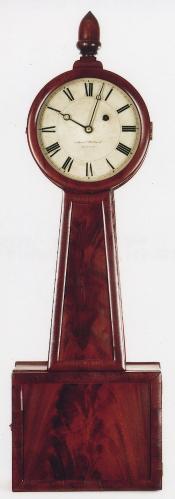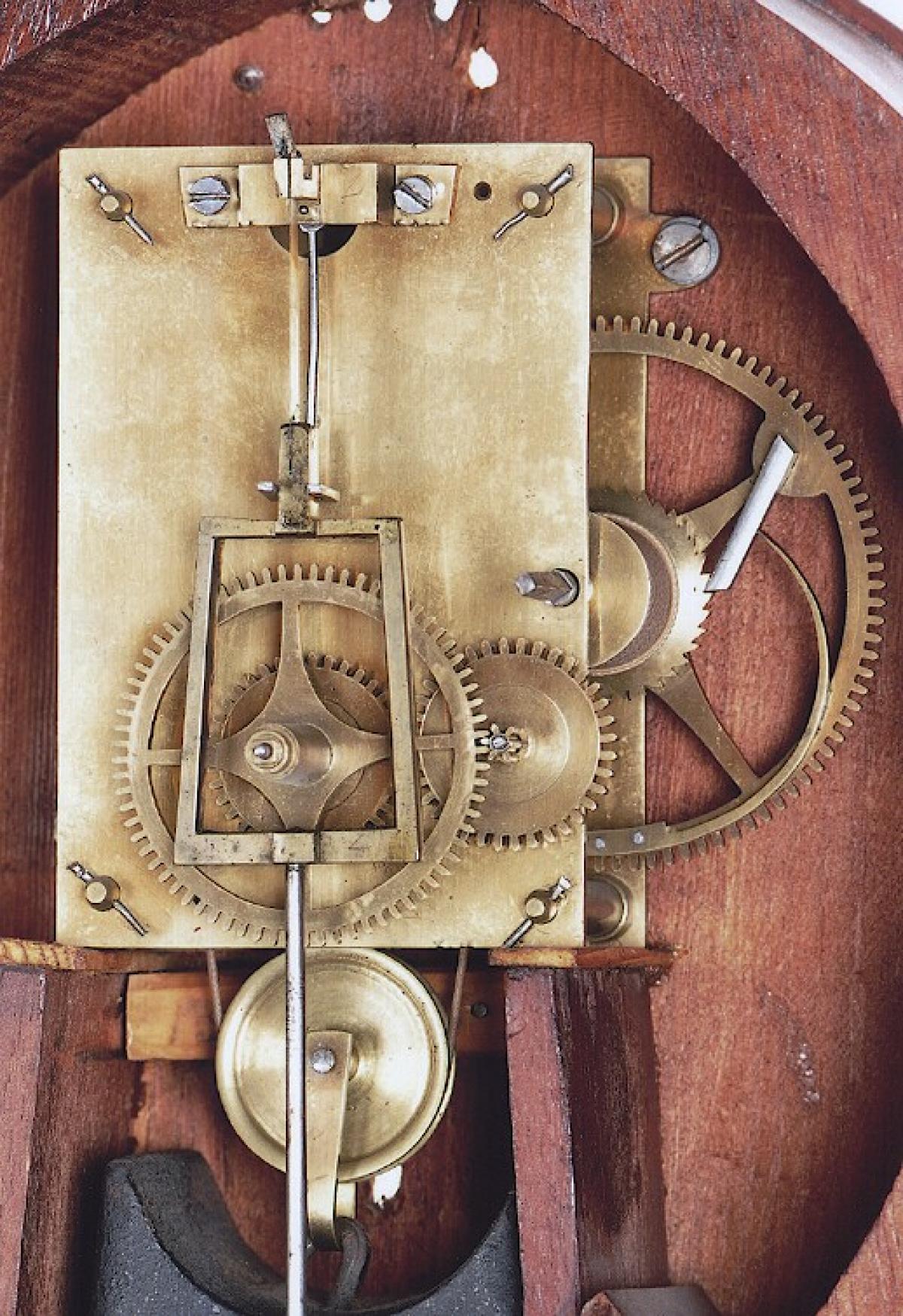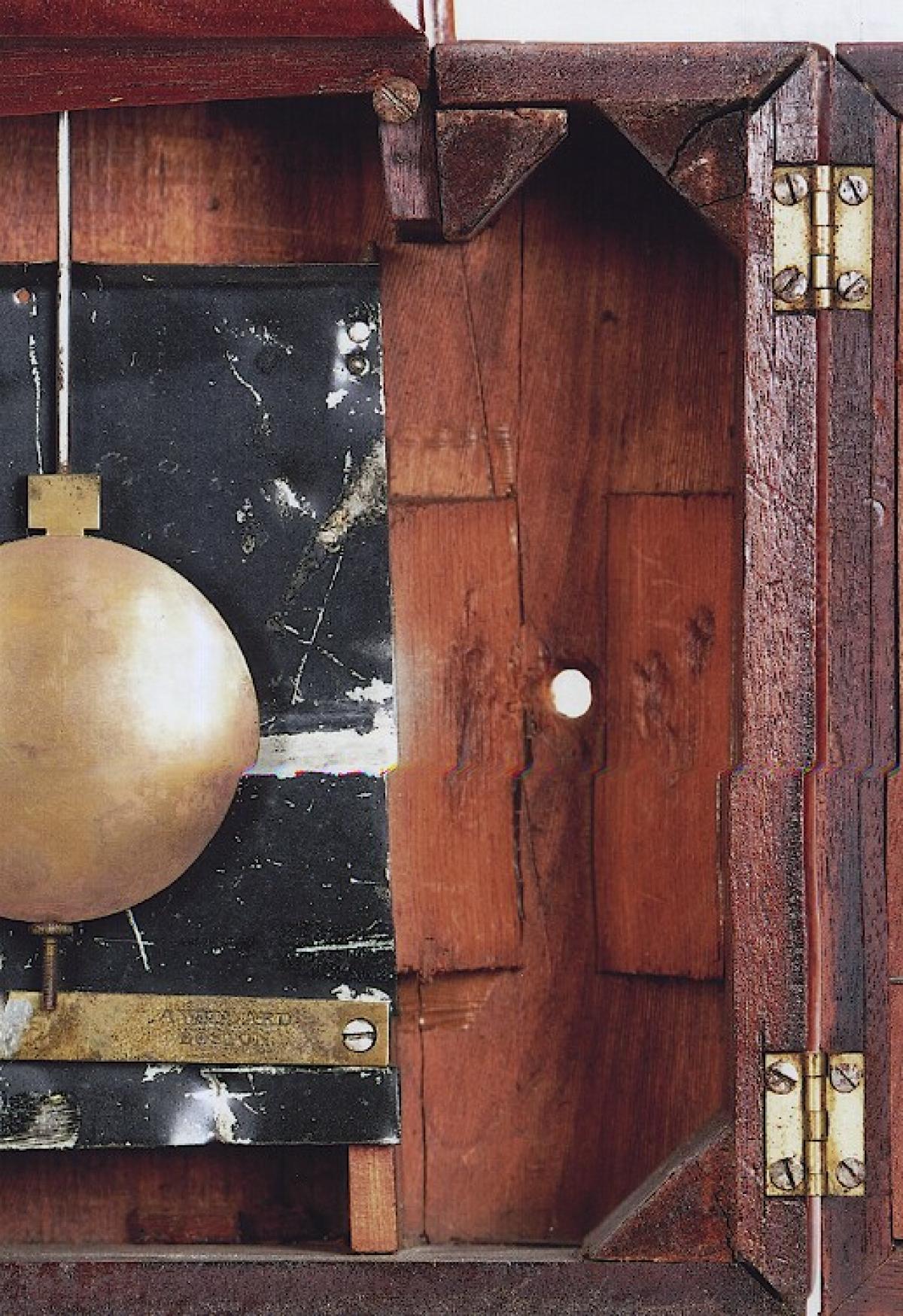Aaron Willard of Boston, Massachusetts. Wall Timepiece or banjo clock. TT-129.
This decorative Federal Massachusetts Wall Timepiece or "Banjo clock" was made by Aaron Willard in Boston, Massachusetts, circa 1830.
The case is constructed in mahogany and features mahogany half-rounded frames. The frames are fitted with wonderfully figured mahogany veneered wooden panels. The mahogany is veneered on pine. The top of the case is fitted with a mahogany plinth and turn acorn finial. The wooden bezel is fitted with glass and opens to a painted iron dial. The Clockmaker signs this enameled dial in script lettering. It reads, "A. Willard / Boston." The signature is in excellent condition. This dial features a traditional time ring that is formatted with Roman hour numerals. The time is indicated by nicely shaped open moon steel hands.
The movement is constructed in brass. The plates are rectangular-shaped. The movement is secured to the backboard with two screws through the backplate. The screws pass through the "ear mounts." The weight-powered movement is wound with a key through the dial. A lead weight drives this mechanism which is designed to run for eight days on a full wind. The Pendulum is covered in brass. The tie-down is also die-stamped by the Maker.
This attractive clock measures approximately 34.5 inches long overall.
Inventory number TT-129.
Aaron Willard was born in Grafton, Massachusetts, on October 13, 1757. Little is currently known of Aaron's early life in Grafton. His parents, Benjamin Willard (1716-1775) and Sarah (Brooks) Willard (1717-1775) of Grafton had eleven children. Aaron was one of four brothers that trained as a clockmaker. In Grafton, he first learned the skills of clock-making from his older brothers Benjamin and Simon. It is recorded that Aaron marched with them in response to the Lexington Alarm on April 19, 1775, as a private under Captain Aaron Kimball's Company of Colonel Artemus Ward's Regiment. Aaron re-enlisted on April 26 and was soon sent by General George Washington as a spy to Nova Scotia in November. By this time, he had reached the grade of Captain. He soon returned to Grafton to train as a clockmaker. In 1780, Aaron moved from Grafton to Washington Street in Roxbury along with his brother Simon. Here the two Willards establish a reputation for themselves as fine clock manufacturers. They were both responsible for training a large number of apprentices. Many of these became famous clockmakers in their own right. The Willards dominated the clock-making industry in the Boston area during the first half of the nineteenth century. Aaron worked in a separate location in Roxbury from his brother and, in 1792, relocated about a quarter-mile away from Simon's shop across the Boston line. Aaron is listed in the 1798 Boston directory as a clockmaker "on the Neck," His large shop employed up to 30 people, while 21 other clockmakers, cabinetmakers, dial and ornamental painters, and gilders worked within a quarter-mile radius by 1807.
Some important dates for Aaron Willard include...
1783, Aaron married Catherine Gates. They have two children. The first is Aaron Willard Jr who becomes a very accomplished clockmaker. Catherine Gates dies in 1785.
1789, Aaron marries Polly Patridge. Polly has two sisters that also marry clockmakers Abel Hutchins and Elnathan Taber. Aaron and Polly have nine children. Two work-in-the-clock trades. George Willard 1817-1821 becomes a journeyman clockmaker. Henry Willard (1822-1887) trained as a cabinetmaker and made cases for the Willard operation when he came of age.
1792, Aaron builds a large home at 143 Washington Street in Boston. He lives in this house until he dies. This house is also the location of his workshop. A barn is converted into an area to finish wood. Other spaces in the carriage shop are rented to related artisans.
1802-1804, Aaron is in a business partnership with cabinetmaker James Blake as Willard & Blake. Aaron's position is financial.
1804, Aaron he transforms the carriage house and barn into a workshop space for artists, clockmakers, woodworkers, etc. It is now known as Willard's Compound.
1805-1806, Aaron is a financial backer in the partnership of Willard & Nolen. Spencer Nolen (1784-1849) is an ornamental artist who begins painting clock dials. In 1808, Spencer Nolen married Aaron Willard's daughter.
1823, Aaron Willard retires. He is 66 years old.
1844, Aaron died on May 20 and is buried in the Eustis Cemetery in Roxbury.
We have owned a large number of tall case clocks made by this important Maker. In addition, we have also owned a good number of wall timepieces, some in the form of banjo clocks, gallery clocks, as well as numerous Massachusetts shelf clock forms.






